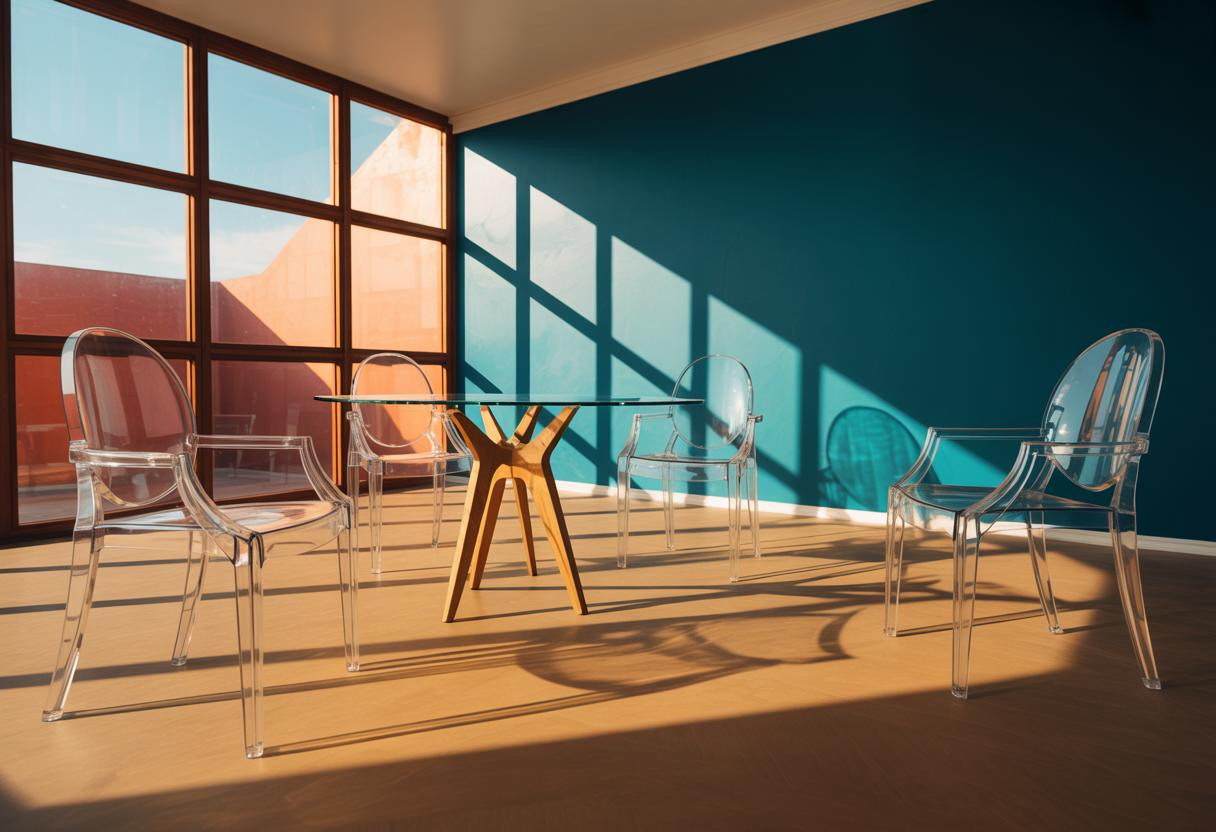Most people think transparent furniture like ghost chairs are purely aesthetic choices, but recent design psychology research reveals they actually trigger specific neurological responses that make spaces feel up to 40% larger than they actually are. This isn’t just visual trickery—it’s a fascinating intersection of material science, cognitive psychology, and architectural innovation that’s reshaping how we think about interior spaces.
The phenomenon works through what designers call “phenomenal transparency,” where the brain processes see-through objects differently than solid ones. When light passes through transparent materials, it creates layered visual depth that mimics the brain’s preference for unobstructed environments that enhance creativity and reduce cognitive load.
The science behind spatial illusion and perception
Ghost chairs exploit fundamental principles of visual psychology through their transparent polycarbonate construction. Philippe Starck’s iconic 2002 design revolutionized furniture by creating what researchers call “visual weightlessness”—the chair exists physically but disappears perceptually.
Studies show that transparent furniture reduces visual “noise” in the same way that decluttered spaces improve focus and reduce stress. The brain processes these chairs as non-obstacles, allowing mental energy to focus on other design elements or tasks.
Material innovation meets psychological comfort
Modern ghost chairs are crafted from single-piece polycarbonate molds that can support up to 400 pounds while weighing just 8-12 pounds themselves. This engineering feat creates furniture that’s simultaneously substantial and ethereal—a contradiction that fascinates both designers and neuroscientists.
The curved design elements, inspired by Louis XVI chairs, trigger positive emotional responses. Research in Psychological Science found that people consistently prefer rounded furniture over angular designs, associating curves with safety and comfort.
Architectural applications across different environments
Ghost chairs perform differently depending on their environment, with surprising results that challenge conventional wisdom about space optimization.
Small residential spaces see dramatic impact
In apartments under 600 square feet, ghost chairs can make dining areas feel 30-50% more spacious compared to traditional wooden chairs. The transparency allows sight lines to extend uninterrupted, creating the illusion of continuous floor space.
However, there’s a counterintuitive finding: in extremely cramped spaces (under 300 square feet), the chair’s form still registers as occupying space, limiting the transparency effect. This suggests an optimal room size threshold for maximum impact.
Commercial environments embrace functionality
Restaurants and event venues prize ghost chairs for their stackability—up to 12 chairs can stack in the space traditionally needed for 4 regular chairs. This storage efficiency, combined with their visual lightness, makes crowded venues feel less claustrophobic.
The property value implications are significant, as spaces furnished with transparent elements consistently appraise higher due to perceived spaciousness and modern aesthetic appeal.
Surprising challenges and material considerations
Despite their advantages, ghost chairs face unexpected limitations that manufacturers are actively addressing through innovation.
Environmental sustainability concerns
Traditional polycarbonate production is energy-intensive and challenging to recycle. However, emerging bio-based alternatives and recycled composites are entering the market, reflecting broader trends toward sustainable material innovations in product design.
Some manufacturers now offer chairs made from 95% recycled ocean plastic, maintaining transparency while addressing environmental concerns.
Cultural adoption varies significantly
Western markets embrace ghost chairs as symbols of minimalist sophistication, but adoption patterns differ globally. In cultures that traditionally value ornate, textured furniture, transparent designs can feel cold or impersonal.
Practical implementation for maximum impact
To optimize ghost chairs’ spatial effects, designers recommend strategic placement near natural light sources and using them as accent pieces rather than primary seating in traditional homes.
For commercial spaces, combining ghost chairs with warm lighting and textured surfaces prevents the “clinical” feeling that pure minimalism can create. The key is balancing transparency with tactile comfort elements.
The future of transparent design psychology
Ghost chairs represent more than furniture—they’re a glimpse into how material innovation can literally reshape our perception of space. As urban living spaces continue shrinking and sustainability concerns grow, transparent design solutions offer a compelling path forward that satisfies both practical and psychological needs.
